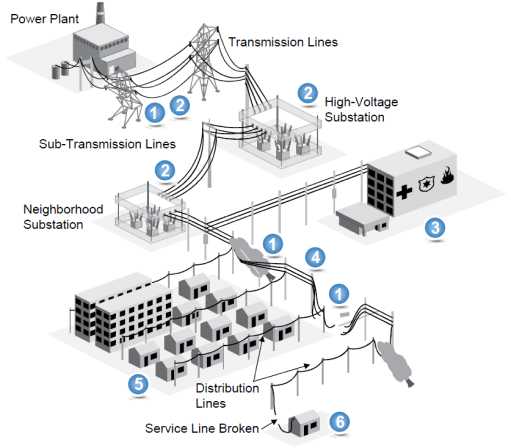How We Restore Power
In the event of widespread outages due to severe weather, power is restored according to the restoration process below.
-
Learn How Reporting Your Outage Helps Us Restore Power
We may not know you are without power. Customers should always let us know if they are experiencing an outage, even if a neighbor has already reported it. Our Outage Management System (OMS) automatically evaluates the pattern of reported outages and determines the likely location of the trouble. The OMS works best when it receives plenty of information to analyze.
Restoring Power After a Storm
How FirstEnergy Prepares for Storms
When severe weather is forecast by our company meteorologists, we activate formal readiness plans to ensure we’re ready to tackle the damage. This may include staffing additional line workers, dispatchers, damage assessors, hazard responders, customer service staff and more.
Depending on the magnitude of the storm, there could be hundreds or even thousands of damage locations that need to be addressed, so this process can be lengthy.
Assessing Storm Damage
Once a storm has passed, damage assessors, typically experienced engineers or flight operators with drones or helicopters, are sent into the field to analyze damage and report back critical on-site information. This work, which could take multiple days when the damage is significant, helps us determine the required resources, establish repair plans and develop estimated restoration times.
During this time, forestry crews and tree contractors also work to clear tree damage so that line crews can make repairs and restore power in some areas.
Once hazard locations have been identified, analyzed and cleared for line crews, line workers follow an established protocol to restore power to customers as quickly and safely as possible.
Prioritizing Restoration Work
When outages are widespread, restoring power to all customers at the same time may not be possible. Our restoration process helps to keep the public safe while crews quickly work to get customers back up and running.
- Isolate hazards and make safe
- Repair high-voltage lines/restore essential functions
- Restore hospitals and other critical medical facilities, police and fire departments, and 911 facilities
- Repair main feeder/distribution lines
- Restore areas with largest number of customers
- Restore individual homes

-
More Details About Our Power Restoration Process
Our priority immediately following a storm is to clear hazards, such as downed power lines, downed trees and equipment blocking the roads. Hazard responders are dispatched to damage locations, such as downed lines, to protect the public from these hazards until a line crew has arrived to make the area safe. While hazard responders are not qualified to make repairs, their support is necessary to ensure everyone remains safe until repairs are completed.
Generally, transmission and substation facilities are repaired first since they supply power to the lines serving communities, neighborhoods and individual customers. Next, we give priority to hospitals and other critical medical facilities, communications facilities and emergency response agencies. After that, crews work to restore power as quickly as possible to the rest of our customers, typically addressing outages that restore the largest number of customers before moving to more isolated problems.
Note: When outages occur, we are only responsible for restoring electric service to our customers. If other utility services such as telephone or cable TV are also affected, please contact those companies to have services restored.
Mobilizing Additional Crews
Local crews are well equipped to handle less-extensive storm damage in their own areas. For more widespread outages, we can call on employees from surrounding service centers or bring in crews from other FirstEnergy electric companies. If a storm is especially severe, we may also supplement our own crews with local contractors or request workers from neighboring electric companies through mutual assistance relationships.

